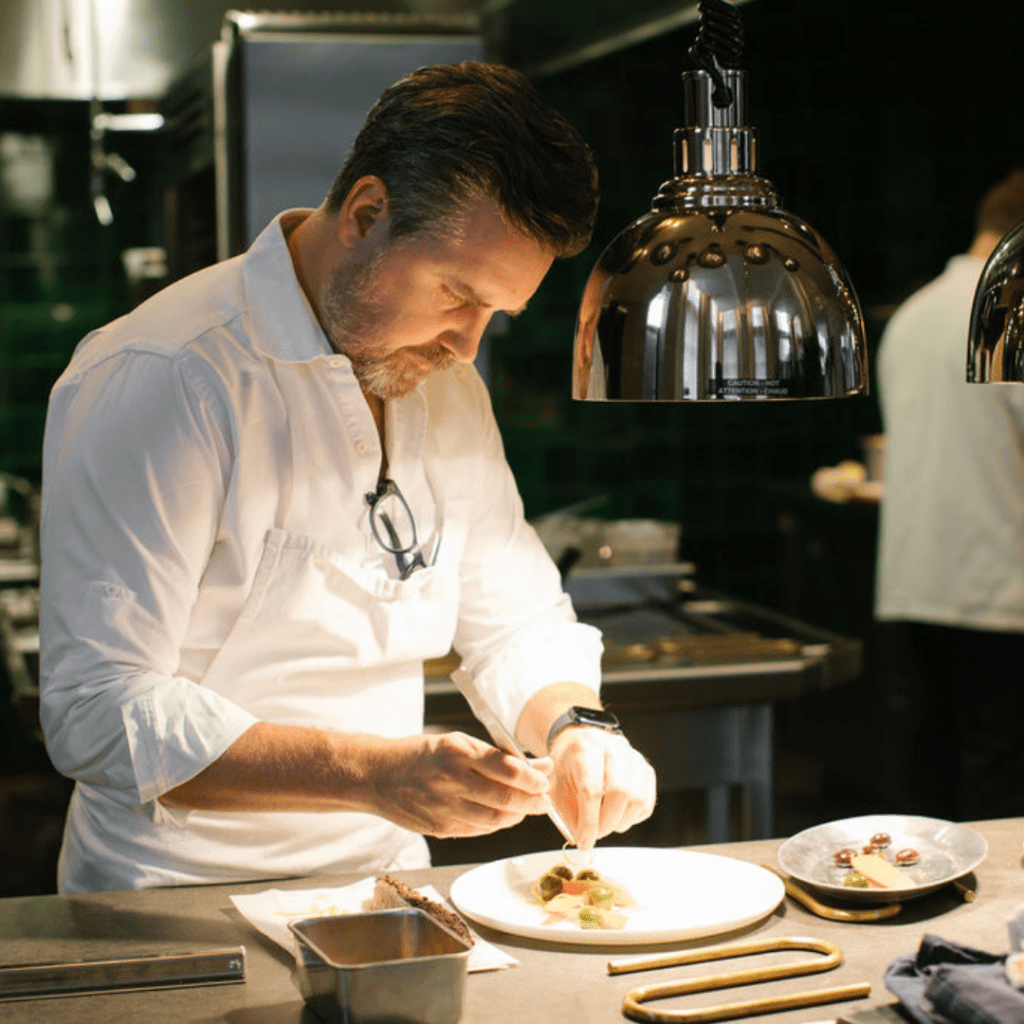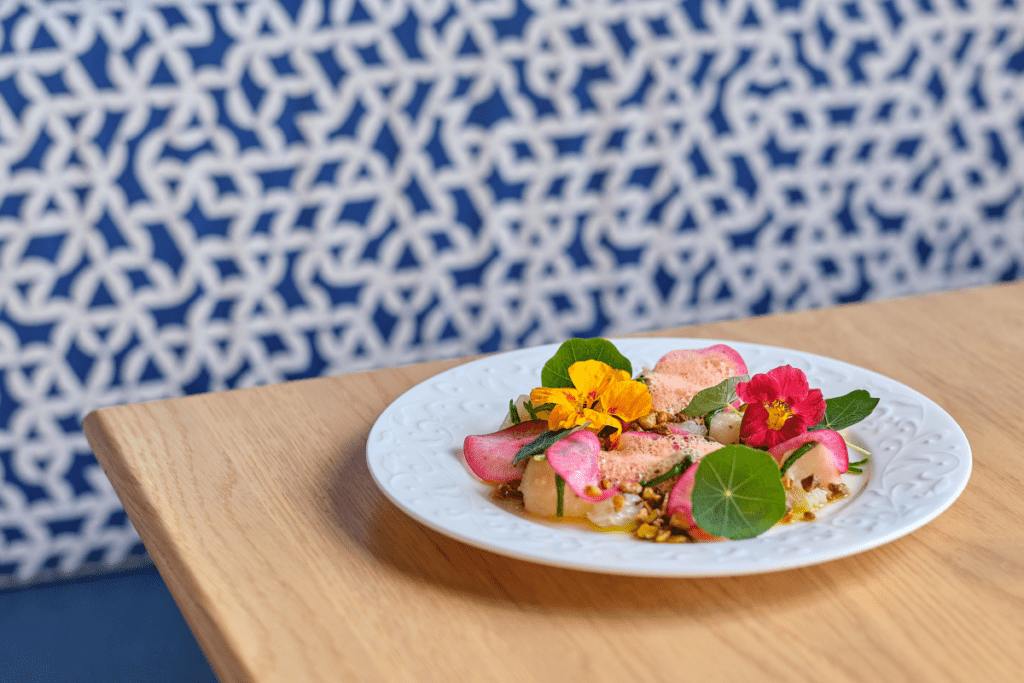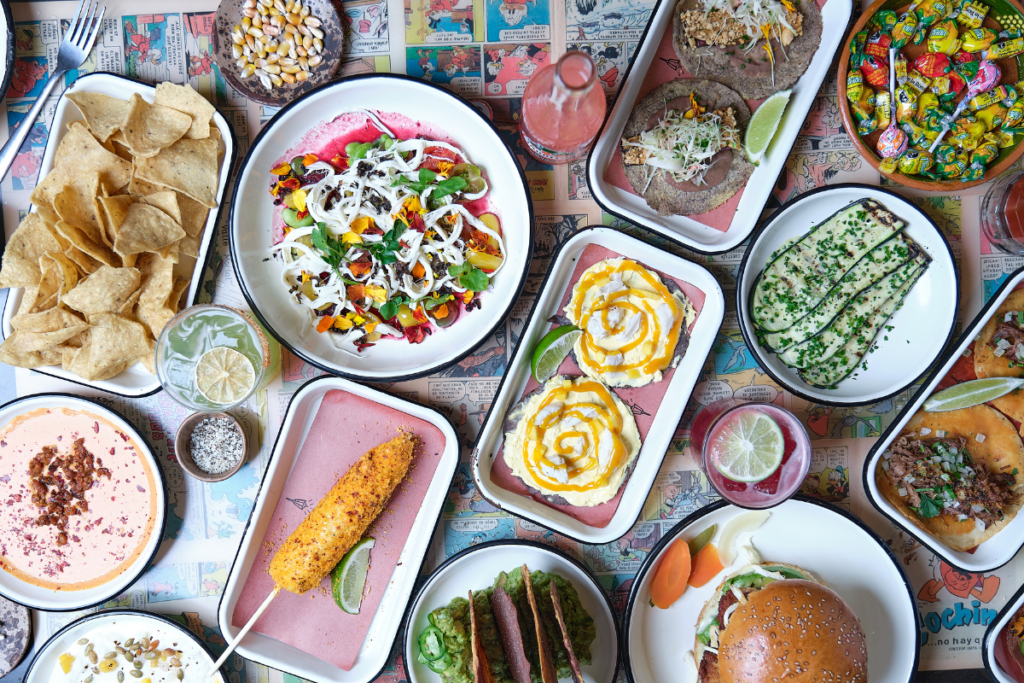by Eric Barton | November 18, 2024
Where To Eat in Tampa: A Gourmand’s Guide
Discover where to eat in Tampa with its dining scene invigorated by Michelin stars while still fiercely loyal to the Cuban sandwich.

It’s the same in a lot of cities: somehow everybody has agreed on a shared personality. Friendliness in Kansas City. Brash-talking Boston. Philadelphia, the town that boos Santa. For Tampa, the personality of the city is founded on the backs of cigar factory workers, soldiers and mullet fishermen. It’s a city of pioneer women who became some of the first in the country to demand the right to vote. Tampa, it seems, is the city of the underdog.
Tampa is where pirates ducked into bays to outsmart armadas. Where natives chased away conquistadors. And Tom-effing-Brady—too old, past his prime. Yet a champion again, the ultimate Tampa story.
It happened again in 2022. Like the introduction of a new antagonist in Tampa’s backstory, the Michelin Guide arrived in Florida that year. Its inspectors scoured the dining scene of Tampa, Miami and Orlando. And to the restaurants in Tampa, they awarded a grand total of zero stars.
Since then, I’ve heard stories about how that rejection became fuel in the bellies of the city’s chefs. Restaurant owners and chefs wanted more than ever to show just how good things were in the city’s dining scene. Not only to prove the French tire makers wrong but also because they could. That’s what underdogs do.
So I went on a culinary tour of the city, a trip that spanned the outer and inner reaches of its dining scene from the finest Cuban sandwich outpost to its renowned steakhouse and through an entirely new entertainment district that didn’t exist just a few years ago. I’m going to spoil the ending here by saying what I discovered was a vibrant food culture worthy not just of Michelin’s recognition but also a trip of your own. Here’s where to eat in Tampa, Florida’s city of comebacks.

Finding Religion in a Sandwich
Jeff Houck was a cub reporter at The Palm Beach Post when he sat down alone for lunch at a table for four in West Palm Beach’s famed Havana restaurant. He ordered the Cuban. It was 1993.
“The heavens opened, and I heard the angels and everything became sunny and beautiful,” Houck said with a dramatic flourish in his voice, only half kidding. He realized right then that there were about seven or eight recipes represented in just that one sandwich. Somebody had spent considerable time
baking Cuban bread, roasting and shredding pork, slicing ham and brining pickles.
Houck eventually landed at the then Tampa Tribune and became obsessed with the Cuban. He started writing about the sandwich, a habit that would turn into a book he co-authored, “The Cuban Sandwich: A History in Layers.”
I met Houck, 59, on a rainy-then-sunny-then-rainy afternoon during my trip to The Boozy Pig. It’s a West Tampa butcher shop that makes a version of the Cuban sandwich with nearly every ingredient made from scratch. “This place is the new standard-bearer for the Cuban,” Houck said.
All the food we loved in New York and Japan, it wasn’t available.
—Eric Fralick
Those are big words considering Houck’s day job as the vice president of marketing for the 1905 Family Of Restaurants, which owns the Columbia Restaurant, maker of one of the city’s most famous Cuban sandwiches. But Houck said The Boozy Pig represents a new era in Tampa where chefs have begun meticulously sourcing their ingredients. It’s not just sourcing ingredients from local farms, as so many chefs began doing in the past generation, but also obsessing.
A couple hours after my lunch with Houck, I knocked on the door of Koya restaurant and found the sous chefs working on their mise en place a couple hours before service. Owner and chef Eric Fralick, 48, offered his hand and then took a seat beside me at the counter.
Koya exists today largely because Fralick ended up with roommates from Japan when he moved to New York. They convinced him to go home with them, and what he figured would be a three-month trip turned into five years. Once back in New York, he met his wife, Adriana, a Tampa native who convinced him to move home with her in 2014. He found a city where restaurants were dominated by big-box chains. “All the food we loved in New York and Japan, it wasn’t available.”

So in 2019, they opened a sushi place, Noble Rice. After it took off, they began offering omakase, essentially chef’s choice sushi. People liked it so much that soon 75% of their business was the omakase menu. They moved Noble Rice in 2020 to a bigger location at Sparkman Wharf and converted the original space into Koya, an eight-seat sushi counter where people now pay $295 for a multicourse omakase. It’s rare to find an empty seat.
It’s not just that omakase was new for Tampa. It’s also that Fralick goes to insane lengths to source ingredients. While nearly every Japanese restaurant has to go through the same purveyor for fish, Fralick figured out in 2019 how to buy directly from Tokyo’s fish market. He arrived to the cargo area at Tampa International Airport one day five years ago to find cardboard boxes with his name on them. Inside were Japanese newspapers wrapped around Styrofoam coolers of fish. “The quality of the product, it was just a night-and-day difference,” he said.
Our top three restaurant recommendations for St. Petersburg
The end result, for instance, is an uni, or sea urchin, far creamier, richer and tasting more of the briny ocean off northern Japan. He keeps the Easter-egg-colored boxes they come in on shelves behind the sushi counter, lined up like heirlooms. What follows is a course served every night at Koya, where a slice of the sunrise-colored uni sits above milk bread toast with fuji apple, light soy, aged balsamic and a brown butter. It came to him, he said, as most of his dishes do, from “many sleepless nights.”
In 2023, Koya joined Rocca and Lilac to become the first three Tampa restaurants to receive a Michelin star. It’s helped reservations, no doubt, but it’s also led to something few people would’ve predicted: young chefs who want to work at a renowned restaurant send their CVs to Fralick’s inbox daily. And it definitely wasn’t always this way.

The Michelin Touch
For one of my favorite meals during my Tampa trip, I didn’t go far, just down 12 flights to the lobby of the JW Marriott Tampa Water Street. It’s one of the towers in the Water Street development that took up what used to be an unloved bit of land near downtown and is now full of hotels and condos and a trolley line heading to the historically Cuban Ybor City. From my booth in the JW’s restaurant, Driftlight Steakhouse, I could see the open kitchen, where sous chef Gayeon Baek, 33, was teaching two of her new line cooks how to plate her scallop dish.
She walked the dish over to me afterward, and I asked if she had a minute to join me. It’s a stunning arrangement, plated all on the left side of a big platter, the crispy-seared scallops over a light parsnip puree, crunchy ribbons of celery and fennel, well-seared mushrooms and a sweet-smoky bacon marmalade. It’s delicate and balanced, like everything I ate of Baek’s cooking.
Afterward, I walked a block north to Lilac, which takes up one end of the Tampa Edition luxury hotel’s lobby. They do a four-course dinner for $150 with stunning tweezer-plated dishes designed by New York chef John Fraser.
Baek and Fraser, two talents who could be working anywhere, simply wouldn’t be in Tampa without Michelin.

It’s also true for Bryce Bonsack, 35, who went to Tampa Catholic High School and eventually ended up at culinary school in New York. He worked at two, two-star Michelin spots in the city before coming back to Tampa to visit his folks while he was between jobs. That’s when he got talked into opening
Rocca, named for a family he stayed with while traveling through Italy. It opened in October 2019, suffered in the pandemic and then was nearly lost to a fire and a flood. It quite literally rose from those ashes to receive the first 10/10 rating from the notoriously fussy Tampa Bay Times writer Helen Freund before receiving its Michelin star.
Since then, Bonsack has seen a consistent stream of emails from chefs wanting to work at his Michelin-starred place. “What Michelin brings to the table is it brings the level of talent back to Tampa,” Bonsack said. “People like me who grew up here and want to establish their resumes can now do that in Tampa.”
That’s just not the way I’m going to do it. I get obsessive about something like this, and it has to be perfect.
—Michael Bannock
The fact that Michelin-quality places are working in Tampa said something, too. On the morning before I left town, I dropped into Boulon Brasserie and Bakery, a French restaurant in one of Water Street’s office towers, Thousand & One. Back in a tiny corner of the kitchen I joined pastry chef Summer Bailey, 47, as she rolled out pie dough, making sure not to overwork it so the chunks of butter would stay together, assuring the cooked pie dough would be flaky.
As she worked, Bailey recalled how last year somebody suggested she sell pies from Boulon’s attached bakery (a steady stream of people were buying baguettes, madelines and vegan-yet-luscious chocolate zucchini muffins on the morning I was there). To get the pies out in one day, Bailey arrived at 3 a.m. to go on to sell 120 of them. For $38, people could choose between pumpkin cheesecake with a Biscoff crust, pecan with a pretzel crust or salted caramel apple. They sold out before midday.

“People were excited because they were visiting family and they could say, ‘Hey, I got this great pie from Boulon, and it was made with love,’” Bailey said. As she spoke, she folded the dough in half, laid it out over a tin and then crimped the edges using a three-finger technique.
The fact that people in Tampa wanted her pies and were willing to pay a few dollars more than at the supermarket across the street, it says something about where things are in the city, she believes. “I don’t know if something changed or if people here always wanted to eat better, but there are so many places in town now doing really amazing things.”
After coming from New York, Bailey got her start in Tampa at an old classic, Bern’s Steak House. I told Bailey I had been the night before. “Okay, so, how was it?” she asked. We talked about Bern’s like two football fans analyzing yesterday’s Bucs game. Was it good? Worth the money? It’s a sport of sorts in Tampa to analyze the city’s oldest restaurant, and my answer to those questions is coming soon.

Bern’s Truth & One Great Tortilla
I’d never been to Bern’s Steak House before and so, on my second night in town, I took a college friend I hadn’t seen in 20 years. I wondered why Michelin had passed Bern’s over, and I started my night with a tour, something any dinner guest can do, weaving through all its dining rooms with alabaster statues, light box artwork and plush carpets and then into the kitchen so busy it feels like a Christmastime airport.
They sat us in a tiny dining room where they say presidents have sat at a four-top near the door to the kitchen, just in case they needed to be whisked out by Secret Service agents. By many measures, Bern’s is outrageously dated, in no way a Michelin-quality restaurant. That’s obvious by the starters and sides that come with every steak order: cracker-like slices of bread, a bone-dry baked potato, a cafeteria-quality iceberg salad and soft green beans.
But if I lived in Tampa, I’d still go to Bern’s for every birthday. The tuxedo-clad waiters, the ice-cold martinis, the strip steak with its perfect sear, the parade of well-dressed wedding guests: it’s a celebration. There’s also the wine list, said to come from what may be the country’s largest restaurant
cellar with a half-million bottles. Unbelievably, more than a hundred of them are offered by the glass. I ordered a glass of a 1974 Rothschild cabernet, the oldest wine I’ve ever consumed. The price: $28.

Still, though, it wasn’t my favorite meal in Tampa. That happened on my way out of town, when I stopped at Streetlight Taco and talked with Michael Brannock, 44, the chef and owner, while sitting at the bar. Brannock was in fifth grade in Sparta, North Carolina, when he found himself captivated by Spanish class, this idea of deciphering a foreign language was fascinating to him. He’d befriend anybody who spoke Spanish in school and soon found himself invited to quinceaneras and birthday parties. That’s where he had tortas and tamales—the food that would become his obsession.
By the time he opened Streetlight in January 2024, Brannock had already become a regular visitor to Mexico. He wanted his restaurant to serve the lesser-known regional dishes and ingredients of Mexico. The tortillas here, for instance, are made from corn sourced from farmers in Mexico and then ground in-house using stone wheels in the molino to create fresh ground masa and hand-pressed that day into imperfect circles. They are, I’ll tell you, the best tortillas I’ve ever had, the corn smooth and flavorful, nutty and earthy. I liked them best with the sweet potato taco, dotted with pomegranate seeds for crunch and thin-sliced charred jalapeno.
It would be easier and cheaper to buy tortillas from a restaurant delivery service, and there was a time in Tampa when customers would’ve thought that was just fine. “That’s just not the way I’m going to do it,” Brannock said. “I get obsessive about something like this, and it has to be perfect.”
His obsession got the attention of Michelin, which gave him a Bib Gourmand, which recognizes restaurants that serve good, lower-cost food. It happened just three months after opening.
Now he has locals who come weekly, sometimes more. And tourists who come directly after getting off their plane, having read about Streetlight in the Michelin Guide. Like I did, people ask Brannock whether he’s going to open other spots. Such success can quickly lead to that. But for now, he said, he’s thinking
about what new regional Mexican dish to obsess over.

Streelight, I should mention is located in the space of a former barbecue restaurant on Henderson Boulevard, one of those quintessential Florida roads of congestion and chains. There’s a UPS store next door.
It’s like that in Tampa these days, good food in so many places. This underdog city, where the restaurant scene has seen its rise, is finally receiving the recognition it deserves as a place where you can
undoubtedly eat very well.
Where To Eat in Tampa
Want to hit up the places I mention in my trip? Here’s where to find them.





